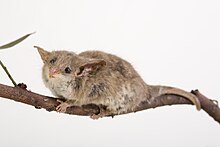Tasmanian pygmy possum
| Tasmanian pygmy possum[1] | |
|---|---|

| |
| Scientific classification | |
| Domain: | Eukaryota |
| Kingdom: | Animalia |
| Phylum: | Chordata |
| Class: | Mammalia |
| Infraclass: | Marsupialia |
| Order: | Diprotodontia |
| Family: | Burramyidae |
| Genus: | Cercartetus |
| Species: | C. lepidus
|
| Binomial name | |
| Cercartetus lepidus (Thomas, 1888)
| |

| |
| Tasmanian pygmy possum range | |
The Tasmanian pygmy possum (Cercartetus lepidus), also known as the little pygmy possum or tiny pygmy possum, is the world's smallest possum. It was first described by Oldfield Thomas in 1888, after he identified that a museum specimen labelled as an eastern pygmy possum in fact represented a species then unknown to science. The holotype resides in the Natural History Museum in London.[3]
Description
Although it is a marsupial, the Tasmanian pygmy possum superficially resembles a dormouse, and it is the smallest of all the known species of possum.[3] Adults range from 6.6 to 7.5 centimetres (2.6 to 3.0 in) in head-body length, with a 6 to 7.2 centimetres (2.4 to 2.8 in) tail, and weigh just 7 to 10 grams (0.25 to 0.35 oz).[4] Their fur is soft and thick, and is fawn in colour over most of the body, fading to a pale grey on the underparts.[3]
The snout is short with long
Distribution and habitat
The Tasmanian pygmy possum is found throughout
The oldest fossils for this species date from the late Pleistocene, and were found on the mainland, with the oldest known Tasmanian fossils being much younger. Fossils have been found as far afield as eastern Victoria and New South Wales, suggesting that the species was once much more widespread than it is today.[3]
It had been feared that the Kangaroo Island population may have been wiped out by the
Behaviour
The Tasmanian pygmy possum is nocturnal and
Biology
Tasmanian pygmy possums are omnivorous, feeding on insects, spiders, small lizards, nectar, and pollen, the latter two primarily coming from Banksia and eucalypts. Their preference for eating pollen without destroying the host flower may mean that they help to pollinate some species of plant. Known predators include Tasmanian devils, quolls, kookaburra, masked owls, and tiger snakes.[3]
During cold weather, especially below about 6 °C (43 °F), Tasmanian pygmy possums have the ability to enter torpor. While in this state, body temperature drops, and oxygen consumption falls to just 1% of normal.[7]
Breeding occurs throughout the year, although it may be more common in spring and summer. The female has a well-developed pouch containing four teats, which therefore limits the maximum size of a litter to this number. The young leave the pouch at around 42 days, although they may cling to the mother's fur and be carried about after this age. They leave the nest to fend for themselves at around 90 days of age.[3]
References
- OCLC 62265494.
- ^ . Retrieved 12 November 2021.
- ^ doi:10.1644/842.1.
- .
- doi:10.1071/ZO01071.
- ^ Carter, Mahalia (2020-12-06). "Tiny possum discovered on Kangaroo Island after fears bushfires had wiped them out". ABC News. Australian Broadcasting Corporation. Retrieved 2020-12-07.
- S2CID 34145896.

